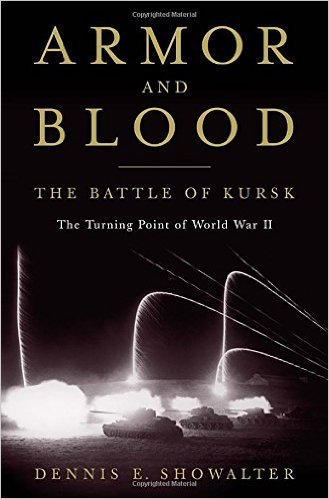
W.J. Astore
I recently read “Armor and Blood” by Dennis Showalter. It’s about the Battle of Kursk in July of 1943, the massive, last-ditch offensive by the Nazis on the Eastern Front, and how the Soviet Army was able to stymy it, seize the initiative, and take the offensive for good. As Showalter notes, the Nazi offensive at Kursk in 1943 was much like the Ludendorff Offensives in the Spring of 1918 near the end of World War I. They were offensives of desperation. As General Ludendorff said in 1918, first we’ll punch a hole in the enemy’s lines, and then we’ll see. Tactical zeal (and wishful thinking) took the place of careful strategic calculation.
In 1918 as well as in 1943, the German military was given free rein to pursue a military solution when there wasn’t one to be had. Germany simply didn’t have the military means for the strategic end they sought to achieve. In 1918, Ludendorff believed he could defeat the Entente forces (the French, British, and other allies, to include the rapidly arriving Americans) on the Western Front, but his offensives only served to weaken his own army, ensuring its exhaustion and defeat by that November. In 1943, Hitler gambled he could defeat the Soviet Army at Kursk, but his massive offensive only weakened his own army, ensuring its exhaustion and eventual defeat in the spring of 1945. Both times, more military action only precipitated defeat and disaster.
Is the United States the inheritor of this Germanic bias? Instead of punching a hole, the U.S. military speaks of “surges.” It surged in Iraq in 2007. It surged in Afghanistan in 2010-11. But after each “surge,” the situation in those countries was basically the same – and, over time, grew worse.
Of course, U.S. “surges,” in each case involving roughly 30,000 additional troops, were in scale dwarfed by the German offensives in 1918 and 1943, involving millions of men and the movement of entire armies. But scale is less important than process. In each case, “victory” was staked on more military action, in part because both Germans and Americans believed themselves to be in the possession of “the finest fighting forces in the history of the world.” Neither, of course, would admit that they were fighting on foreign soil, that the enemy had agency too, and that the longer the fighting continued, the weaker they grew as the enemy grew stronger. So, in the name of “victory” the German and American “surges” played themselves out, and nothing changed strategically – there were no victories to be had.
The Germans, of course, drove themselves to utter collapse, both in 1918 and especially in 1945, after which they could no longer fool themselves as to the success of their “surges.” A superpower with enormous resources, the United States is not yet on the verge of collapse. But enormous budgetary deficits, driven in part by endless wars and a plethora of imperial commitments and overseas bases, are gradually eating away at the sinews of American strength, even as militarism eats away at the marrow of democracy.
After their utter defeat in 1945, the Germans learned to avoid endless war and the seductions of militarism. The question is: Will it require a total collapse of the American Empire before its leaders learn the same lesson?


Well put. A question Americans really need to consider and act on. Unfortunately, like the faux citizens of those other empires, we will probably not take the real threat seriously.
LikeLike
Can’t help but be reminded of Kipling’s admonition:
“And the end of the fight is a tombstone white with the name of the late deceased,
And the epitaph drear: A fool lies here who tried to hustle the East.”
LikeLike
And one of my favorite stanzas from the old British imperial jingoist:
When your’e wounded and left on Afghanistan’s plain
And the women come out to cut up what remains
Then roll to your rifle and blow out your brains
And go to your gawd like a soldier
If only the hothouse orchids who infest the U.S. government — in both of our political and military corporate subsidiaries — would personally lead the charge into Mesopotamia and the foothills of the Hindu Kush, perhaps these endless U.S. crusades wouldn’t last more than a few months and America would have much better and more sane people left at home to do the country’s real work in the world.
Anyone that the U.S. government dispatches overseas to involve themselves in “doing military stuff” ought to remain overseas “for the duration.” No more careerist ticket-punching rotations for failing-upwards decorations, promotions, and early retirements. Especially when it comes to American/Zionist crusades in the middle-east, our so-called “soldiers” and hired-gun mercenaries should grow beards, convert to Islam, and take Muslim wives (lots of orphaned girls and widowed women to choose from) so as to better understand and appreciate what they have come to destroy for war-profiteers in their corporate suites. That ought to provide the proper motivation for staying home and letting the indigenous peoples work out their own way of life as best they see fit.
Kipling had it right about the graveyard of empires. Too bad for the United States that its political/military “elite” regard a steadily deepening hole in the ground as “peace.”
LikeLike
There are so many jobs, Mike, that are dependent on U.S. military interventionism and weapons sales. Meanwhile, in my old hometown, the big talk is whether a casino can be built to create jobs and restore the economy. Yet another casino. In a city where we used to make shoes for America.
Our economy is increasingly a combination of the merchants of death and casino capitalism — but perhaps I repeat myself?
LikeLike